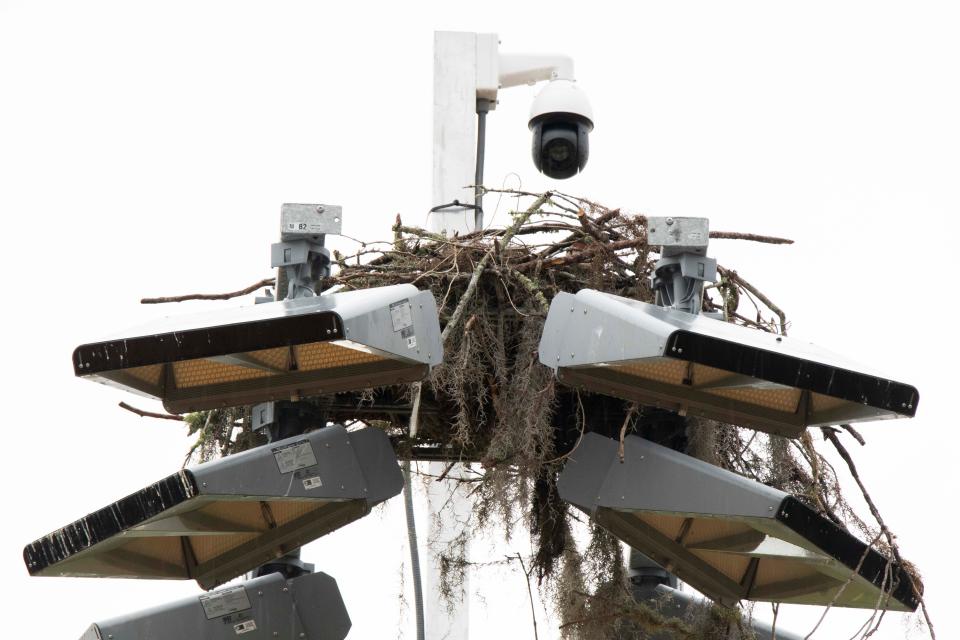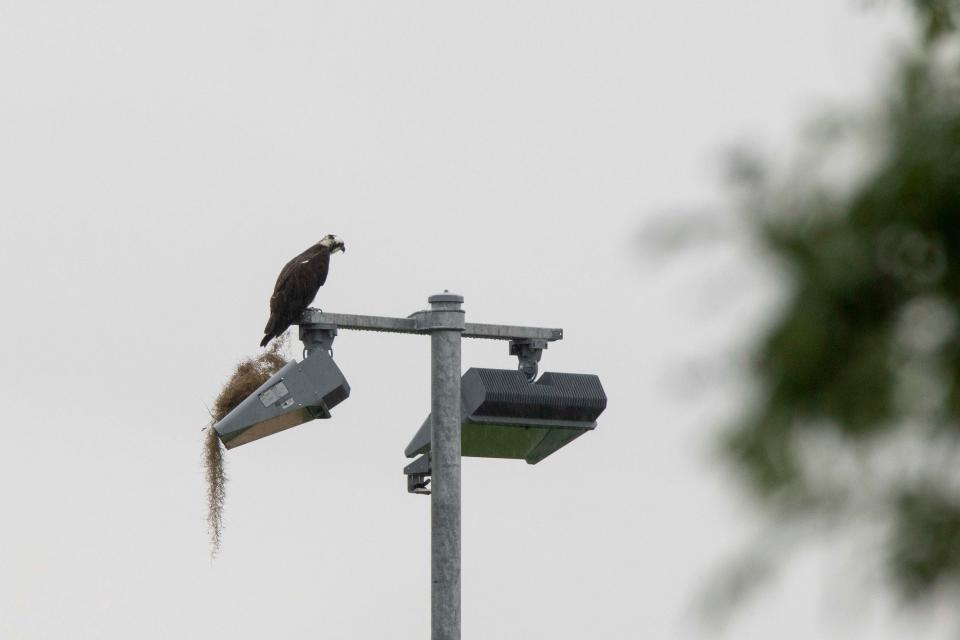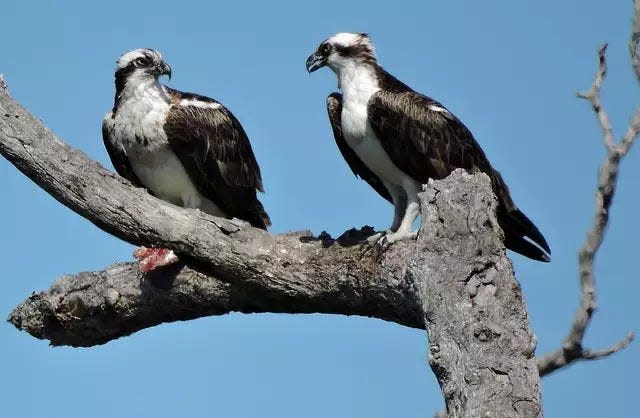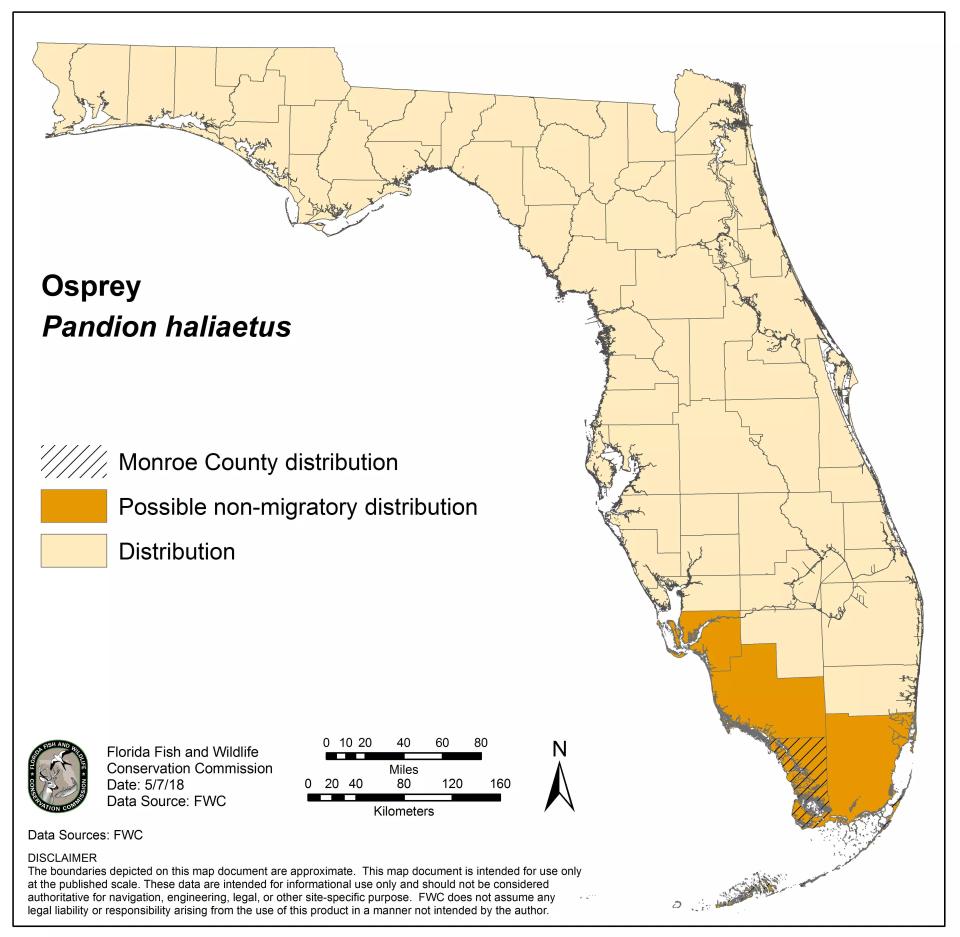Watch via webcam as osprey parents scramble to keep up with new chicks over UF softball fields
Move over E23. There's a few new kids on the block trying to take over your social media fame.
Osprey Stella laid three eggs in a nest overlooking the University of Florida field in Gainesville. As of Sunday, she and her mate, Talon, are now parents. No doubt, they're very busy feeding them as they wait for the third chick to emerge.
You can watch what's happening via a UF live video feed over the nest, along with an estimated 70,000 others around the world.
Thousands have watched E23 of SWFL Eagle Cam fame as it hatched earlier this year. The famous offspring of M15 and F23 can be seen flying regularly near the nest tree at Dick Pritchett Realty and beyond in North Fort Myers.
How to watch ospreys hatch at UF via live webcam

Stella laid her first egg this season on Feb. 21, followed by another Feb. 23 and the last one on Feb. 27, according to UF's ospreycam website.
Their 100-pound nest may look like a fixer-upper, but it's perched 75 feet high, on top of a light pole between UF softball fields. The nest is made up moss, twigs and other organic material. It's been their home for the past two years.
The site is jokingly referred to as “Home Plate” and “The Cheap Seats,” according to University of Florida Institute of Food and Agricultural Sciences.
Watch the ospreys on University of Florida ospreycam

Mark Hostetler, a professor of wildlife ecology and conservation at UF’s Institute of Food and Agricultural Sciences, is the one who spotted an opportunity to set up the "ospreycam" after noticing in 2016 ospreys had made a nest on top of a light pole in the right outfield of McKethan Stadium.
“I thought to myself, ‘This is a great educational opportunity,’” Hostetler said. “People see these ospreys, but they don’t really know much about their natural life history, what they’re doing in the nests.”
He put a camera above the nest, and it began broadcasting video footage streamed online. Game attendees could tune in and observe the birds during innings.
When Condron Ballpark replaced McKethan Stadium, Hostetler searched across the UF campus for a new nest to film before settling on the intramural softball fields, where several nests were located. He and his team used a boom crane to position a camera above a nesting site.
Based on the incubation period of ospreys, Hostetler originally guessed the first egg would hatch around April 2. By Sunday, two of the eggs have hatched.
➤ Ospreycam: Watch the osprey eggs hatch
How to identify an osprey

Sometimes mistaken for a bald eagle, the osprey can reach a height of 23 inches and have a wingspan of 72 inches, according to the Florida Wish and Wildlife Conservation Commission. That's a 6-foot wingspan.
They have a white underside and head, and a brownish upper body with a black line across the eyes that extends to the wings.
If you get close enough, several features help distinguish the osprey from other birds of prey, including a reversible fourth toe and spines on their feet.
The undersides of the toes on each foot are covered with short spines, which help them grasp slippery fish.
Where do ospreys live?

The osprey is found year-round in Florida both as a nesting species and as a spring and fall migrant passing between more northern areas and Central and South America, according to the FWC.
Ospreys in Florida did not suffer the serious pesticide-related population declines that occurred in other states in the 1950s and 1960s. Pesticides, shoreline development and declining water quality continue to threaten the abundance and availability of food and nest sites for ospreys.
Osprey habitat includes the coast, lakes, rivers, and swamps in Florida. There is a non-migratory, resident subpopulation of osprey in coastal southern Florida
Nests are found in large trees, as well as manmade structures, including utility poles, channel markers, power poles and other platforms. Both ospreys and eagles are known to nest on cell towers the FWC said.
Like other birds of prey, ospreys will reuse their nests for many years.
Ospreys and their chicks
In courtship, the male will bring food to the female to keep her from mating with another osprey.
Females lay two to four yellowish eggs that are incubated for approximately 32 days, the FWC said.
Both adults tend to the eggs and nestlings, though the female does more while the male brings food to the nest.
Young osprey take their first flight around 55 days after hatching, and the adults feed young until they are approximately 100 days old.
What does an osprey sound like?
The sound of an osprey screaming, along with high-pitched chirps and shrieks, was what had UF students asking Hostetler what the bird was.
Ospreys have high-pitched, whistling voices, according to AllAboutBirds.
"Their calls can be given as a slow succession of chirps during flight or as an alarm call — or strung together into a series that rises in intensity and then falls away, similar to the sound of a whistling kettle taken rapidly off a stove.
"This second type of call is most often given as an unfamiliar osprey approaches the nest. As the perceived threat increases, the call can build in intensity to a wavering squeal."
➤ National Park Service recording of osprey
Is the osprey endangered?
The osprey is protected by the U.S. Migratory Bird Treaty Act.
Although it is no longer listed as a Species of Special Concern, it is still included in the Imperiled Species Management Plan.
This means the birds, their nests, and their eggs are protected by federal and state law. Inactive nests,those with no young or eggs present, of non-listed species can be removed without a permit.
If a raptor nest is active with eggs or chicks in the nest, removal permits are needed from the U.S.Fish and Wildlife Service.
This article originally appeared on Treasure Coast Newspapers: Osprey cam on University of Florida campus: Stella, Talon new chicks

